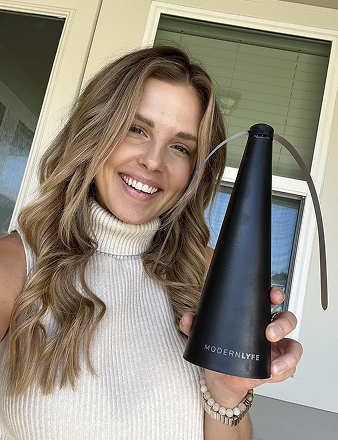A fly fan over your door creates a powerful, invisible air curtain. This constant downward airflow is too strong for flies, gnats, and mosquitoes to penetrate. It physically blocks them from entering, giving you a chemical-free pest control solution that just works.
Why an Over Door Fly Fan Works
Forget sprays and sticky traps. A fly fan is a permanent upgrade. It uses fluid dynamics to generate a consistent, high-velocity air barrier from the fan unit down to the floor.
Think of it as an invisible forcefield. Flying insects have lightweight bodies and can't navigate through such a strong, directed current. When a fly approaches your open door, it hits this wall of air and is immediately blown away, unable to cross the threshold.
More Than Just Pest Control
While keeping bugs out is their main job, these fans also help with climate control. They create a barrier that minimizes air exchange between indoors and outdoors. On a hot day, your cool air stays in. In winter, warm air stops escaping every time the door opens.
This dual functionality is why they are standard in commercial settings where sanitation and comfort are critical.
- Restaurant Kitchens: A fly fan over a delivery door is the first line of defense against pests contaminating food prep areas.
- Warehouse Loading Docks: An air curtain is essential for protecting inventory. It keeps insects and dust out while allowing people and equipment to move freely.
- Home Patios: Enjoy a summer evening with your patio doors open without a swarm of flies joining you. That's what these fans deliver.
The core idea is proactive prevention. You’re stopping pests at the door before they become a problem, instead of dealing with them after they’re inside.
The proven effectiveness of these systems has built a massive market. The global market for specialized insect control air curtains was valued at around $593 million in 2025 and is projected to grow. They are fundamental in sensitive environments like food processing plants and hospitals.
Still wondering if they're right for you? Our guide explores the question in more detail: https://modernlyfe.com/blogs/articles/do-fly-fans-work
How to Choose the Right Fly Fan for Your Doorway

Picking the right fly fan over door is critical for creating a pest-free zone. It’s all about matching the fan's power and size to your specific doorway. Get it right, and you get an invisible shield. Get it wrong, and you've just installed a noisy decoration.
First, measure the width and height of your doorway. The fan unit must be at least as wide as the opening—a little wider is even better. If it's too short, you’re leaving gaps for pests to sneak through.
Understanding Fan Power and Airflow
With your measurements ready, look at the CFM, or Cubic Feet per Minute. This number tells you how much air the fan moves. Higher CFM means a stronger barrier against insects.
For a standard residential patio door about 7 feet high, a fan rated between 600-900 CFM is usually enough to stop houseflies and mosquitoes. For a busy commercial kitchen entrance, you’ll need something more powerful, likely 1200 CFM or higher, to handle the constant traffic and pest pressure.
Matching the Fan to Your Space
Different doorways have different needs. The installation location and local pests will determine the type of unit you should get.
- For Your Home: A back patio or garage door needs a model that prioritizes quiet operation and a modern design. A compact axial fan is often a perfect choice.
- For Commercial Buildings: A restaurant, warehouse, or storefront needs a high-velocity air curtain with a durable motor that can run for hours and withstand frequent use.
Axial fans are a great all-around option because they’re efficient and compact. Their popularity is growing as more people seek energy-saving, quiet models that meet modern environmental standards.
The goal is an unbroken column of air that flows from the fan to the floor. If the airstream is too weak, flies will simply fly under it. Always confirm the fan you choose is rated for the height of your door.
This table helps you narrow down the options based on common door types.
Fly Fan Feature Comparison for Different Doorways
This table breaks down the key features to look for when selecting a fly fan, helping you match the model to your specific needs.
| Doorway Type | Recommended Fan Width | Minimum CFM Rating | Key Feature to Look For |
|---|---|---|---|
| Standard Residential Door | 36 inches or wider | 600 CFM | Quiet Operation & Sleek Design |
| Double Patio Doors | 72 inches or wider | 900 CFM | Variable Speed Control |
| Restaurant Kitchen Entry | 42 inches or wider | 1200 CFM | High-Velocity Motor, NSF-Rated |
| Warehouse Loading Dock | 8-10 feet | 1500+ CFM | Industrial-Grade Durability |
Choosing the right fan from the start saves headaches later. By considering your doorway's size, traffic, and environment, you can install a system that works perfectly from day one.
For a deeper dive, check out our detailed guide on selecting the best fly blower for doors. A few minutes of research ensures your fly fan over door is a smart, effective investment.
A Practical Guide to Installing Your Door Fan
Mounting your fly fan over the door is a manageable DIY project. It's no more complicated than installing a sturdy shelf. Let's walk through the steps to get it done right for a secure and effective installation.
First, unbox the fan and check all the parts against the manual's list. Confirming you have every screw and bracket now saves a frustrating trip to the hardware store later.
Prepping for a Solid Mount
Next, gather your tools. You will need:
- A drill with the correct bits
- A level
- A pencil
- A stud finder
The stud finder is essential. These fans are heavy and must be anchored into the solid wood framing inside your wall—drywall alone is not strong enough.
Once you locate the studs above the doorway, mark your mounting points. Hold the fan's bracket against the wall and use your level to ensure it's perfectly straight. A crooked fan looks bad and can affect airflow and strain the motor. Mark exactly where to drill.
Pro Tip: Mount the fan as close to the top of the door frame as possible, leaving just enough clearance so the door doesn't scrape it. This placement creates the most effective air barrier with no gaps for pests.
With your spots marked, drill the pilot holes. Then, securely attach the mounting plate or brackets using the included hardware. Give them a firm tug to ensure they're rock-solid before hanging the fan unit.
Finalizing the Installation
With the brackets secure, you can now hang the fan. On most models, the main unit simply slots or bolts onto the bracket. This step is much easier and safer with a helper, so ask a friend to assist you.
The final step is power. Many residential fans plug into a standard outlet. If your model requires hardwiring, safety is the top priority. Unless you are a qualified electrician, hire a professional. They will ensure the fan is connected safely and up to code. If you're still weighing your options, explore some of the best door fans designed to keep bugs out.
These systems are becoming more common. The Industrial Air Curtain Market was valued at around USD 812.85 million in 2025 and is expected to reach USD 1.33 billion by 2030, driven by the growing need for improved sanitation and comfort. You can see more details about this market growth on ResearchAndMarkets.com.
Fine-Tuning Your Fan for Maximum Pest Defense
Mounting your fly fan over door is the first step, but fine-tuning is what creates a truly pest-proof shield. A few small adjustments will transform it into an invisible defense system for your doorway.
The main goal is to create a powerful, unbroken curtain of air. The most important adjustment is the angle. Don't aim for a straight-down blast. Instead, direct the airflow slightly outward and downward to push flies away from the entrance before they get close.
Dialing in Speed and Airflow
Next is fan speed. The perfect setting depends on daily conditions, such as pest levels and wind. Find the sweet spot where the airstream is strong enough to reach the floor but not so aggressive that it's a nuisance to people.
- On quiet days: A lower, quieter setting is usually sufficient when there aren't many flies.
- On busy or windy days: For a commercial kitchen or on a windy day, increase the speed to maintain a solid air barrier.
Of course, a solid physical installation is the foundation for any fine-tuning. This visual breaks down the core process.

As the infographic shows, a proper installation—from marking the placement to securely mounting the unit—is essential for an effective pest defense.
Smart Automation for Hands-Off Efficiency
For a true "set it and forget it" solution, integrate simple automation. Connecting your fly fan to an automatic door sensor is a game-changer.
This setup ensures the fan turns on only when the door opens, which dramatically cuts energy use and reduces wear and tear on the motor.
Linking the fan to a door switch does more than save on your electric bill. It creates a fully automated pest control system that activates only when needed. That's the efficiency that makes it a smart, long-term solution.
Keeping Your Fly Fan in Top Shape
Your door fly fan works hard, and a little maintenance goes a long way. A few minutes of simple upkeep will ensure it protects your entrance reliably for years. Think of it as a quick checkup to prevent bigger issues later.
The most important task is to keep the air intake vents clean. This is where dust and debris collect, and it's the #1 cause of reduced airflow and motor strain. A quick wipe-down or vacuum once a month is usually all it takes.
Listen for Performance Cues
Beyond cleaning, pay attention to how your fan sounds and performs. Your senses are the best early warning system for small issues.
- Listen for odd noises: A new rattle, buzz, or grinding sound often signals a loose screw or a misaligned part that needs tightening.
- Feel for vibrations: With the fan running, place your hand on the casing. If it vibrates more than usual, check that all mounting brackets are still snug.
A well-maintained fan provides a consistent, powerful air curtain. This regular attention ensures you get the reliable, pest-free protection you paid for.
To make this easy, add it to a routine checklist. Using a simple preventive maintenance schedule template helps you track these vital tasks. This simple habit protects your investment and keeps your entryway clear.
Your Questions About Over-Door Fly Fans, Answered
You understand the benefits, but you probably have a few practical questions. Let's tackle the most common concerns about noise, cost, and installation so you can make a confident choice.
How loud are they?
It depends on the model. A heavy-duty commercial unit for a warehouse will be louder than a sleek fan designed for a home patio.
Look for the decibel (dB) rating in the product specifications. Many modern fans, especially those for homes and customer-facing businesses, operate with a gentle hum that blends into the background.
Will this increase my electric bill?
Generally, no. Most over-door fly fans are energy-efficient, often using less power than a standard ceiling fan.
For maximum efficiency, choose a model with variable speed settings and pair it with a door switch.
This setup is a game-changer. The fan only runs when the door is open, which drastically cuts energy use and extends the motor's life. It’s a smart, set-it-and-forget-it approach.
Can I install it myself?
If you're comfortable with basic DIY projects, absolutely. Most plug-in models are designed for straightforward installation that you can complete in an afternoon.
However, if the fan requires hardwiring into your electrical system, hire a qualified electrician. It's the only way to guarantee the installation is safe, correct, and compliant with local codes.
Ready to create a pest-free zone with an effective and stylish solution? Check out the range of quiet, powerful fly fans from MODERN LYFE and find the perfect model for your space at https://modernlyfe.com.






